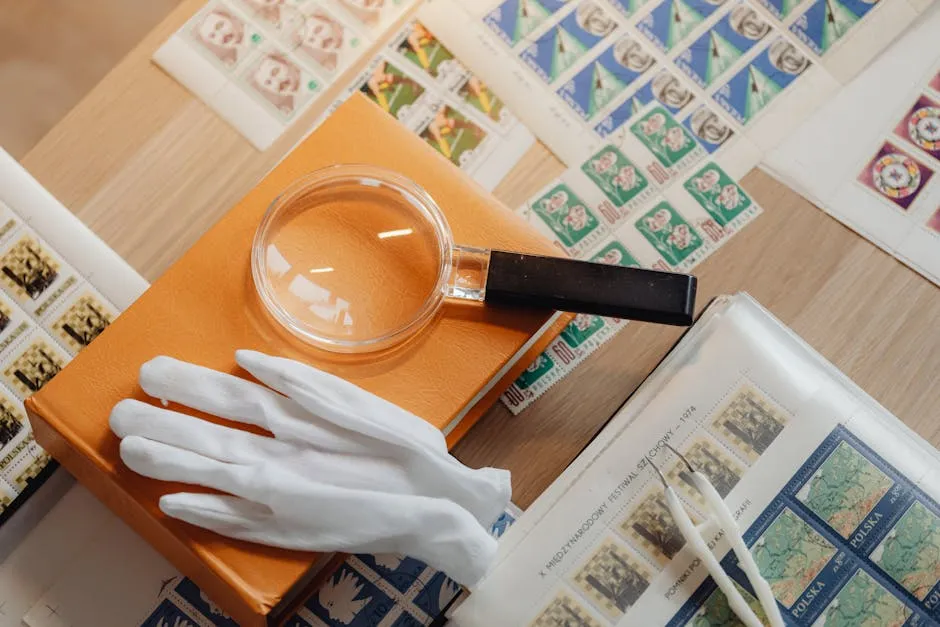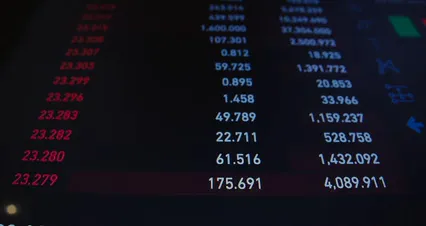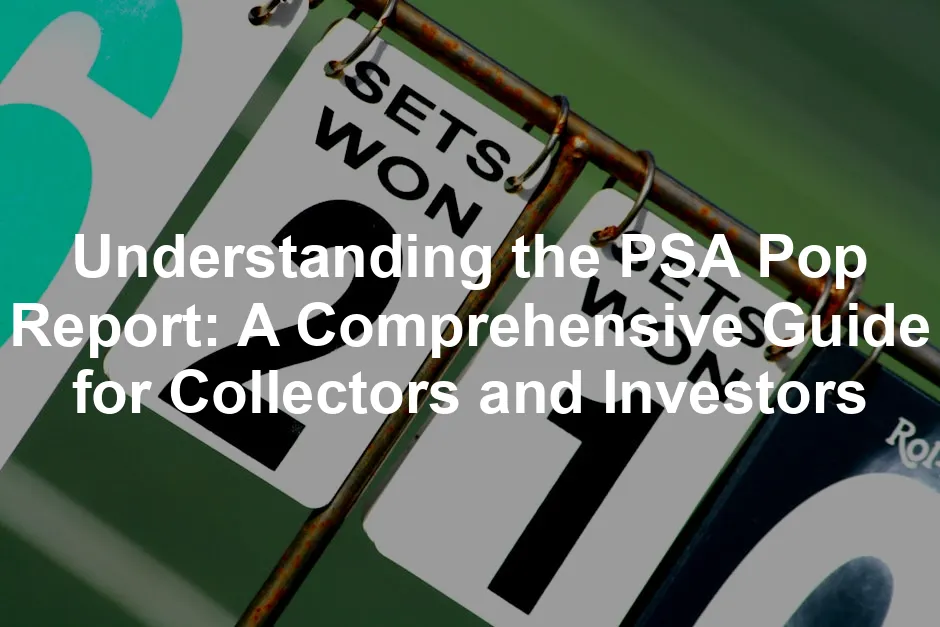Introduction
In the vibrant world of sports card collecting, knowledge is truly the golden ticket. Enter the PSA Pop Report, a treasure trove of data that can make or break your collecting experience. This report serves as an essential compass for collectors and investors alike, steering them toward informed decisions that can lead to significant gains—or losses.
Wondering why this report is crucial? It offers insights into the availability of graded cards, helping collectors gauge rarity and value. Have you ever pondered how many Michael Jordan rookie cards exist? Or which cards could potentially skyrocket in value? The PSA Pop Report holds answers to these burning questions, and more.
Navigating the Pop Report might feel overwhelming at first. Fear not! This guide will clarify its features, show you how to use it effectively, and explain why it holds such weight in the collecting community. Spoiler alert: understanding this report can turn you from a casual collector into a savvy investor.
Think of the PSA Pop Report as your trusty sidekick in the bustling adventure of card collecting. It empowers you to make decisions backed by data rather than gut feelings. With the right knowledge, your collecting prowess will reach new heights. Get ready to unlock the full potential of your investment strategy and explore the hidden gems within the Pop Report.
By the end of this article, you’ll be well-equipped to harness the power of the PSA Pop Report. Whether you’re a card-carrying collector or a budding investor, understanding this resource is your key to success. Grab your favorite beverage, settle in, and let’s embark on this enlightening journey together!

What is the PSA Pop Report?
Definition and Purpose
The PSA Pop Report, also known as the Population Report, is a detailed database that tracks the number of cards graded by PSA (Professional Sports Authenticator). Think of it as a scoreboard for collectors! This report provides insights into the total population of each card, including how many exist at various grades.
Why is this important? For collectors and investors, the PSA Pop Report is like a crystal ball. It reveals the rarity of cards, helping you understand their potential value. If a card has a low population, it’s often more sought after. Conversely, a high population can mean lower value. This knowledge helps collectors make informed decisions about buying, selling, and trading.
For investors, the Pop Report serves as a vital tool. Knowing the supply of a card allows investors to gauge demand and predict future price movements. In a market where every penny counts, the PSA Pop Report is pure gold.
Speaking of cards, if you’re serious about preserving your collection, consider investing in PSA Graded Card Holders. They provide the perfect protection for your prized possessions, keeping them safe from dust, scratches, and the occasional coffee spill.
Historical Background
PSA was founded in 1991, quickly establishing itself as a leader in sports card grading. Initially, grading standards were inconsistent across the industry. Collectors often faced uncertainty about card values. The introduction of the PSA Pop Report marked a significant turning point.
In the late 1990s, as the card collecting hobby grew, the need for reliable data became clear. PSA recognized this gap and launched the Pop Report in 1999. This groundbreaking tool provided transparency and consistency, enhancing collector confidence.
Over the years, the Pop Report has evolved. PSA has continually improved its grading standards, ensuring accuracy and reliability. This commitment to quality has solidified PSA’s reputation as the go-to grading service.
Milestones in the development of grading standards include the introduction of numerical grading scales and the establishment of clear criteria for card conditions. These advancements have helped collectors better understand their investments.
As the collecting community has expanded, so too has the importance of the PSA Pop Report. Today, it remains an essential resource for anyone serious about sports cards. And if you want to keep all your cards organized, a Sports Card Collecting Storage Box will do the trick. It’s like a treasure chest for your valuable cards!

How to Access the PSA Pop Report
Step-by-Step Guide
Accessing the PSA Pop Report is straightforward. First, head over to the PSA website. Look for the “Pop Report” link, usually found in the main navigation menu. Click on it, and you’ll be taken to the report interface.
Once there, you can search for specific cards. Enter the card name or player in the search bar. The Pop Report will display the total population and breakdown by grade. This information is crucial for assessing the card’s market position.
Navigating the interface is user-friendly. You can filter results by sport, year, and set. This allows you to hone in on specific cards quickly. Familiarizing yourself with these features will enhance your experience.
Tools and Resources
To elevate your Pop Report experience, consider using third-party tools and websites. Platforms like GemRate provide additional insights and analytics. They track trends in grading and offer valuable data on card values.
Some collectors also use community forums to discuss their findings. Engaging with fellow enthusiasts can provide unique perspectives and tips. And if you’re looking for a way to protect your cards while discussing them, grab some Ultra Pro 9-Pocket Trading Card Page Protectors. They keep your cards safe while you show them off!
By combining the PSA Pop Report with these resources, you’ll gain a comprehensive understanding of the market. This knowledge will empower you to make smarter decisions in your collecting journey.

Understanding the Data in the PSA Pop Report
Key Metrics Explained
When it comes to the PSA Pop Report, understanding key metrics is crucial for collectors. Let’s break down the main components that paint a clearer picture of your favorite cards.
Total Population: What It Signifies for Collectors
The total population refers to the number of a specific card that PSA has graded. For collectors, this number is significant. A low population suggests rarity, which can drive demand and, consequently, value. Imagine owning a card with only 50 graded copies. That’s a collector’s dream! On the flip side, a high population may diminish desirability. Cards like the 1986 Fleer Michael Jordan can have thousands of graded examples, making them less unique and, often, less valuable.
Grading Breakdown: Understanding the Distribution of Grades (10, 9, etc.)
Another essential aspect is the grading breakdown. PSA assigns grades ranging from 1 to 10, with 10 being the holy grail of card conditions. The breakdown shows how many cards received each grade. For instance, if 1,000 cards are graded, and only 100 received a 10, that’s a strong indicator of how coveted that grade is. Collectors need to pay attention to these numbers. A card with many high-graded copies may face a tougher competition in the market.
Rarity vs. Demand: How Population Impacts Value
Rarity and demand are like the peanut butter and jelly of card collecting. If a card is rare but has high demand, its value skyrockets. Conversely, if there are tons of a card, even if it’s in pristine condition, its value might not be as high. For example, consider the 2003 LeBron James rookie card. It has a relatively low population at the highest grades, driving immense demand among collectors. Understanding this dynamic will guide collectors in making smarter purchasing decisions.
Examples
Let’s put this into context with some iconic cards. Take the 1979 O-Pee-Chee Wayne Gretzky rookie card. It’s one of the most sought-after hockey cards, with only a handful graded at 10. Its total population is around 6,000, but only 90 have achieved that elusive 10 grade. The demand for this card is high among fans and investors alike, driving prices into the stratosphere.
Another example is the 1996 Topps Chrome Kobe Bryant rookie card. While there are over 30,000 of these graded, only about 1,000 are graded at 10. Collectors are willing to pay top dollar to get their hands on a perfect copy, showcasing how the population and grading breakdown work together to influence value.
Understanding these examples allows collectors to interpret the data in the Pop Report effectively. It’s not just about numbers; it’s about knowing how those numbers translate into value and desirability. When you understand these metrics, you can make well-informed decisions in your collecting journey.

Trends and Insights from the PSA Pop Report
Current Grading Trends
The PSA Pop Report is more than a static database; it’s a living document that reveals current grading trends. Recent data shows that in the past week alone, PSA graded over 326,000 cards—an increase of 5% compared to the previous week. This surge indicates a growing interest in card collecting.
When analyzing daily averages, the past month alone reflects an average of nearly 46,840 cards graded per day. This uptick suggests that collectors are particularly active, perhaps driven by recent market shifts or a newfound appreciation for nostalgia.
It’s also worth noting which players and sets are trending. For example, players like Shohei Ohtani and Luka Dončić are hot topics among collectors right now. Their cards are flying off the shelves, and the Pop Report reflects that demand. If you’re looking to jump on this trend, consider grabbing a Sports Card Price Guide Book to keep track of those rising stars!
Historical Comparisons
Understanding current trends also involves looking back. Historically, the market has seen fluctuations based on various factors like player performance, team success, and even external events like the pandemic, which sparked a card-collecting renaissance.
For instance, during the 2020 boom, the PSA reported grading numbers that shot up to an unprecedented 17.1 million cards annually. This was a significant increase from previous years, showcasing how market dynamics can shift dramatically.
Comparing today’s metrics with historical data allows collectors to grasp how the market has evolved. This analysis can guide future investments. If a card’s popularity is on the rise now compared to previous years, it might be wise to jump in before prices escalate.
By keeping an eye on trends and drawing comparisons with historical data, collectors can position themselves to make savvy decisions. The PSA Pop Report is a valuable ally in navigating this ever-changing landscape.

Practical Applications of the PSA Pop Report
Buying and Selling Strategies
Using the PSA Pop Report can transform your buying and selling approach. When it comes to purchasing cards, the report is your best friend. It allows you to make informed decisions based on current market dynamics.
First, check the total population of a card you’re eyeing. A low population often means rarity. For example, if a card has only 50 graded copies, it’s likely to attract more interest. This is your cue to consider investing.
On the flip side, high population cards may not hold as much value. Take the 1986 Fleer Michael Jordan rookie card. While iconic, its high number of graded versions dilutes its rarity. Knowing this helps you avoid overspending.
For selling strategies, understanding population data is key. If you own a card with a low population, this is your leverage in negotiations. Highlight its rarity to justify your asking price. Conversely, if you’re selling a high-population card, be realistic about pricing. The market is saturated; buyers will have many options.
Additionally, consider seasonal trends. Certain cards may surge in popularity during playoffs or special events. The Pop Report can guide you on when to sell for maximum profit. And while you’re at it, why not showcase your collection with a Sports Card Display Case? It’s a stylish way to protect your investments!

Trading Tips
Negotiating trades becomes a breeze with the Pop Report. First, arm yourself with data on both your card and the one you’re aiming to acquire. Understanding the population and grades of both cards allows you to pitch your trade confidently.
For instance, if you’re trading a card with a population of 100 for one with 1,000, you can argue that your card is more desirable. Use this data to negotiate better terms. “Hey, my card is rarer!”—now that’s a strong bargaining chip!
Also, be prepared to show recent sales data. If you can reference recent sales of similar cards, it strengthens your position. This way, you can provide evidence that supports your trade value.
Lastly, don’t shy away from discussing the broader market context. If a player’s performance is on the rise, point that out! It adds urgency to the trade, making your offer more appealing.
Investment Strategies
Investment strategies vary significantly based on Pop Report insights. Let’s break down long-term vs. short-term approaches.
For long-term investments, focus on cards with low populations and high historical significance. An example is the 2003 LeBron James rookie card. As the player’s career progresses, the value of these cards often increases, especially if they maintain low populations in high grades.
Conversely, short-term investments might involve cards that are trending due to current events. For example, if a rookie player starts making headlines, their cards may see a temporary spike in demand. The Pop Report can help you identify these trends quickly. And if you want to keep your investment safe, consider using Cardboard Gold Premium Card Sleeves to protect them!
Understanding the timing is crucial. Spotting a rising trend early can lead to significant gains. But beware—this strategy requires vigilance. Prices can drop just as fast as they rise. Regularly checking the Pop Report keeps you informed on how many cards are being graded and their grades.
In summary, align your investment strategy with the data you gather from the PSA Pop Report. Whether you’re in for the long haul or looking for quick wins, knowledge is your ultimate ally.

Future of Card Collecting and the PSA Pop Report
Predictions for the Industry
The card collecting landscape is changing, and the PSA Pop Report will evolve along with it. As technology advances, expect grading processes to become even more efficient and transparent. Innovations like AI-assisted grading could emerge, enhancing accuracy and speed.
Moreover, the market dynamics are shifting. More collectors are entering the space, driven by nostalgia and investment potential. This influx will likely increase demand for graded cards, influencing population numbers in the Pop Report.
In addition, we might see more detailed analytics incorporated into the report. Imagine insights on trends specific to player performance, team success, or even market conditions. This would provide collectors with richer data to inform their decisions.
The PSA Pop Report may also adapt to cater to new collector preferences. Younger generations might seek out different types of cards, like those from emerging sports or niche categories. PSA will need to keep pace with these trends to remain relevant. Speaking of trends, don’t forget to check out a Trading Card Game Playmat to showcase your style while you play!
Lastly, anticipate a focus on sustainability and eco-friendly practices. As the industry matures, collectors and companies alike will likely prioritize environmentally conscious methods. The Pop Report may reflect these changes, incorporating metrics related to sustainability.
In conclusion, the future of card collecting looks promising. The PSA Pop Report will continue to play a crucial role, adapting to meet the evolving needs of collectors and investors alike. Staying informed about these trends will keep you ahead of the game.

Conclusion
The PSA Pop Report is a game changer for card collectors and investors alike. It’s more than just a list of graded cards; it’s a powerful tool that can elevate your collecting experience. By understanding the data within the report, collectors can make informed choices about which cards to pursue and how much to invest.
Why is this important? For one, the Pop Report reveals the rarity of cards. Knowing how many copies exist at various grades helps collectors pinpoint valuable pieces. Imagine stumbling upon a card with only a handful of graded copies—it’s like finding a needle in a haystack! This knowledge not only enhances your collection but can also lead to significant returns on investment.
Moreover, the Pop Report is your ally in navigating market trends. As the collecting landscape evolves, staying updated on population changes can inform your buying and selling strategies. Are you eyeing a rookie card of a player gaining traction? The Pop Report can help you gauge if you’re making a wise investment. And if you want to maintain your collection’s quality, consider a Sports Card Collector’s Handbook for tips on preservation!
For those who truly want to maximize their potential, digging into the Pop Report is essential. It’s not just about owning cards; it’s about understanding their place in the market. The potential for profit exists for those willing to leverage this data effectively.
So, whether you’re a seasoned collector or just starting, take the plunge! Explore the PSA Pop Report to stay informed about trends and changes in the market. Knowledge is your best friend in this hobby, and the Pop Report is a treasure trove waiting to be explored.
FAQs
What is the best way to use the PSA Pop Report for beginners?
For beginners, start by familiarizing yourself with the Pop Report’s layout. Use it to search for specific cards or players. This will help you understand the total population and grading distribution. Look for cards with low populations, as these tend to be more valuable. Remember, knowledge is power!
How often is the Pop Report updated?
The PSA Pop Report is updated regularly, typically on a daily basis. This ensures that collectors have access to the most current data on graded cards. Checking it frequently allows you to stay informed about changes in card populations and market trends.
Can the Pop Report predict future card values?
While the Pop Report provides valuable insights into rarity and supply, it cannot predict future values with certainty. Card values depend on various factors, including market demand, player performance, and collector interest. However, by analyzing trends in the Pop Report, you can make educated guesses about potential value changes.
What should I do if I can’t find my card in the Pop Report?
If your card isn’t in the Pop Report, it could be due to several reasons. It might not have been graded yet or simply isn’t listed. In this case, consider submitting your card for grading. If it has been graded but doesn’t appear, you may want to check for any spelling errors in your search terms.
How does the Pop Report affect the resale value of cards?
The Pop Report significantly influences resale value. Cards with low populations often command higher prices due to their rarity. Conversely, high-population cards may not sell for as much. Understanding this relationship helps you set realistic expectations when buying or selling cards in the market.
Are there any limitations to the information provided by the PSA Pop Report?
Yes, while the Pop Report is a valuable resource, it has limitations. It doesn’t provide insights into market demand or trends beyond graded populations. Additionally, it may not include every card ever graded, especially if there are discrepancies in the data. Always combine insights from the Pop Report with other market research to make well-rounded decisions.
Please let us know what you think about our content by leaving a comment down below!
Thank you for reading till here 🙂
The PSA Pop Report is a vital tool for understanding the rarity and value of sports cards. Learn more about the PSA Pop Report here.
All images from Pexels




